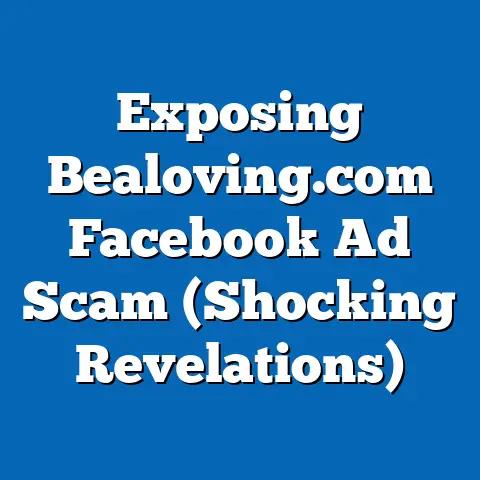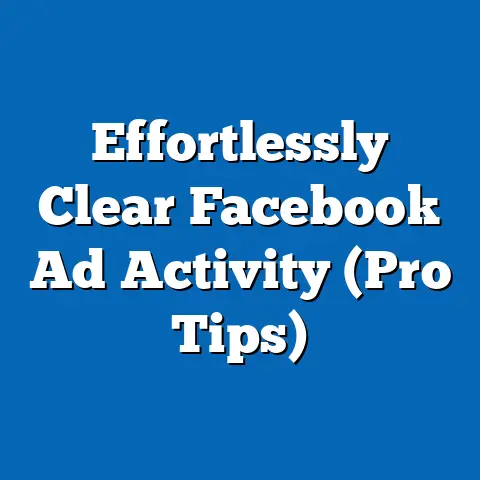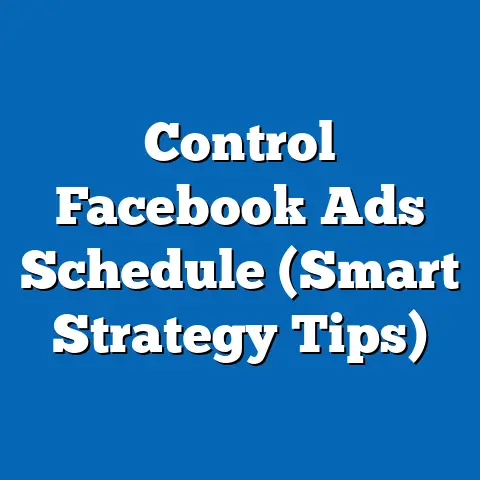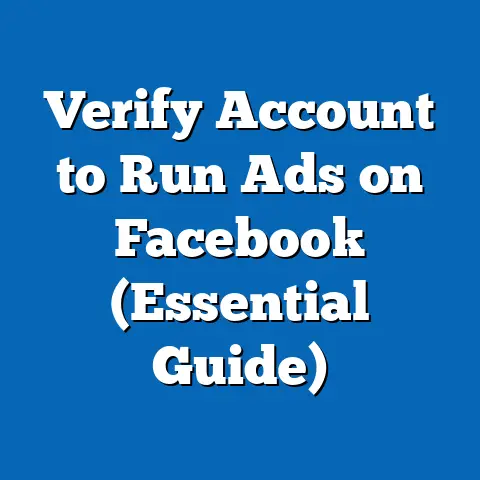Master Facebook Ad Opt-Outs (Expert Strategies Revealed)
As a digital marketing expert, I’ve seen firsthand how user privacy concerns have reshaped the advertising landscape. Gone are the days when brands could relentlessly bombard users with ads without considering their preferences. Today, mastering Facebook ad opt-outs is not just a best practice; it’s a necessity for building trust, maintaining compliance, and ultimately, achieving sustainable advertising success.
Section 1: Understanding Facebook Ad Opt-Outs
Definition and Importance
Ad opt-outs are mechanisms that allow users to control whether they see targeted advertisements. On platforms like Facebook, users can opt out of seeing ads based on their interests, demographics, or even data collected by third-party websites and apps. This means that if a user opts out, they’re telling Facebook, “I don’t want to be targeted with ads based on this information.”
Why is this important? For users, it’s about control and privacy. They get to decide what information they’re comfortable sharing and how it’s used for advertising. For advertisers, it’s about respecting user choices and ensuring that advertising efforts are targeted towards those who are more receptive. Ignoring opt-out preferences can lead to wasted ad spend, negative brand perception, and even legal repercussions.
Current Trends
The trend of consumers opting out of ads is steadily growing. Studies show that a significant percentage of internet users actively manage their privacy settings, including opting out of targeted ads. According to a recent survey by Pew Research Center, 81% of Americans say they feel they have little control over the data that companies collect about them. This growing awareness and concern for privacy are driving more users to take control of their ad preferences.
This trend has a direct impact on advertising effectiveness. As more users opt out, the pool of targetable individuals shrinks, potentially increasing ad costs and reducing reach. Advertisers need to adapt by focusing on quality over quantity, creating more engaging and relevant ads for those who are still receptive to targeted advertising.
Legal and Ethical Considerations
Legal frameworks like the General Data Protection Regulation (GDPR) in Europe and the California Consumer Privacy Act (CCPA) in the United States have significantly influenced the landscape of ad opt-outs. These regulations give users more control over their personal data and require advertisers to obtain explicit consent for data collection and usage.
GDPR, for example, mandates that businesses must have a lawful basis for processing personal data, which includes obtaining consent for advertising purposes. CCPA gives California residents the right to opt out of the sale of their personal information. These laws have forced Facebook and other platforms to enhance their privacy settings and provide users with more transparent and accessible opt-out options.
Beyond legal requirements, there’s an ethical responsibility for advertisers to respect user data and privacy. Building trust with consumers requires transparency and a commitment to ethical data practices. This means not only complying with legal regulations but also going above and beyond to ensure that users feel in control of their data and advertising experiences.
Takeaway: Understanding ad opt-outs is crucial for navigating the modern advertising landscape. By recognizing the importance of user privacy, staying informed about current trends, and adhering to legal and ethical considerations, advertisers can build trust and achieve sustainable success.
Section 2: The Mechanics of Facebook Ad Opt-Outs
How Opt-Outs Work
Facebook provides users with several ways to opt out of targeted ads. The primary tool for managing ad preferences is the Facebook Ads Preferences tool, accessible through the user’s settings. This tool allows users to:
- Control Interests: Users can view and remove interests that Facebook has assigned to them based on their activity on and off the platform.
- Limit Data from Partners: Users can opt out of seeing ads based on data collected by third-party websites and apps that share information with Facebook.
- Hide Ad Topics: Users can hide specific ad topics that they find irrelevant or offensive.
When a user opts out of a specific interest or data source, Facebook will no longer use that information to target ads to them. However, it’s important to note that opting out doesn’t mean the user will stop seeing ads altogether. They will still see generic ads that are not based on their specific interests or data.
User Experience
The user experience related to opt-out options on Facebook has improved over the years, but it can still be confusing for some users. While Facebook has made efforts to make the Ads Preferences tool more accessible, it’s not always easy for users to find and navigate.
The interface is relatively straightforward, but users need to be proactive in managing their preferences. Facebook doesn’t actively prompt users to review their ad settings, so it’s up to the individual to take the initiative. This can be a barrier for less tech-savvy users who may not be aware of the available options.
One area where Facebook could improve the user experience is by providing more context and explanations about how data is used for advertising. Many users are unaware of the extent to which their online activity is tracked and used to target ads. Providing clearer explanations could empower users to make more informed decisions about their ad preferences.
Impact on Ad Targeting
Ad opt-outs have a significant impact on ad targeting, reach, and overall campaign performance. When users opt out of specific interests or data sources, the pool of targetable individuals shrinks, potentially increasing ad costs and reducing reach.
For example, if a business is targeting users interested in “travel” and a large number of those users opt out of seeing ads based on their interests, the business will have a smaller audience to target and may need to increase their ad spend to reach the same number of people.
Ignoring opt-out preferences can have several negative consequences for advertisers:
- Wasted Ad Spend: Showing ads to users who have explicitly opted out is a waste of resources.
- Negative Brand Perception: Bombarding users with unwanted ads can damage brand reputation and lead to negative feedback.
- Reduced Engagement: Ads that are irrelevant to users are less likely to generate engagement, such as clicks, likes, and shares.
Takeaway: Understanding the mechanics of Facebook ad opt-outs is essential for effective ad targeting. By being aware of how users can opt out and the impact of opt-outs on ad performance, advertisers can adjust their strategies to maximize reach and engagement while respecting user preferences.
Section 3: Expert Strategies for Managing Opt-Outs
Proactive Communication
One of the most effective strategies for managing opt-outs is to engage in proactive communication with your audience. Don’t wait for users to opt out; instead, educate them about how their data is used and why they might want to opt into certain ads.
Here are some strategies for informing users about their data usage:
- Transparent Privacy Policies: Make sure your privacy policy is clear, concise, and easy to understand. Explain how you collect, use, and protect user data.
- In-App Notifications: Use in-app notifications to inform users about new privacy features or updates to your data practices.
- Email Campaigns: Send email campaigns to educate users about the benefits of opting into personalized ads. Explain how personalized ads can provide them with more relevant and valuable content.
- Landing Pages: Create dedicated landing pages that explain your data practices and provide users with options to manage their ad preferences.
By being transparent and proactive, you can build trust with your audience and encourage them to opt into personalized ads.
Segmentation and Personalization
Segmentation and personalization are key strategies for improving engagement, even with users who have opted out of certain types of ads. By segmenting your audience based on their opt-out preferences, you can tailor your messaging to be more relevant and engaging.
For example, you can create a segment of users who have opted out of interest-based targeting and show them generic ads that are not based on their specific interests. Alternatively, you can create a segment of users who have opted into personalized ads and show them highly targeted ads that are tailored to their individual interests and preferences.
Personalization can also be used to improve engagement with users who have opted out of certain types of ads. For example, you can provide them with value-driven content, such as blog posts, articles, or videos, that are relevant to their interests but not directly promotional. This can help you build a relationship with these users and encourage them to reconsider their ad preferences in the future.
Monitoring and Analytics
Monitoring opt-out rates and understanding the reasons behind them is crucial for optimizing your ad campaigns. By tracking opt-out rates, you can identify trends and patterns that can inform your future ad strategies.
Here are some tools and techniques for monitoring opt-out rates:
- Facebook Ads Manager: Use Facebook Ads Manager to track the performance of your ad campaigns and monitor opt-out rates.
- Google Analytics: Use Google Analytics to track user behavior on your website and identify potential reasons for opt-outs.
- Surveys and Feedback Forms: Use surveys and feedback forms to gather insights from users about their ad preferences and reasons for opting out.
By analyzing this data, you can gain a better understanding of why users are opting out and adjust your strategies accordingly. For example, if you notice that a large number of users are opting out of ads based on a specific interest, you may need to re-evaluate your targeting strategy or create more relevant and engaging ads.
Re-engagement Tactics
Re-engaging users who have opted out is a challenging but important task. While you can’t force users to change their ad preferences, you can encourage them to reconsider by providing them with value and building a relationship.
Here are some strategies for re-engaging users who have opted out:
- Surveys and Feedback Forms: Use surveys and feedback forms to gather insights from users about their ad preferences and reasons for opting out.
- Value-Driven Content: Provide users with valuable content that is relevant to their interests but not directly promotional.
- Exclusive Offers: Offer exclusive discounts or promotions to users who have opted out.
- Personalized Emails: Send personalized emails to users who have opted out, explaining the benefits of opting into personalized ads.
By providing value and building a relationship, you can encourage users to reconsider their ad preferences and opt back into personalized advertising.
Takeaway: Managing opt-outs effectively requires a proactive and strategic approach. By communicating transparently, segmenting your audience, monitoring opt-out rates, and re-engaging users, you can maximize the effectiveness of your ad campaigns while respecting user privacy.
Section 4: Case Studies and Real-World Examples
Successful Campaigns
Let’s examine a couple of case studies where businesses effectively managed ad opt-outs and saw positive results:
- Company A: E-commerce Brand: This e-commerce brand implemented a proactive communication strategy, informing users about their data practices and the benefits of personalized ads. They also segmented their audience based on opt-out preferences and tailored their messaging accordingly. As a result, they saw a significant increase in opt-in rates and improved engagement with their ad campaigns.
- Company B: SaaS Provider: This SaaS provider focused on providing value-driven content to users who had opted out of certain types of ads. They created a series of blog posts, articles, and videos that were relevant to their audience’s interests but not directly promotional. This helped them build a relationship with these users and encourage them to reconsider their ad preferences.
These case studies highlight the importance of transparency, segmentation, and value-driven content in managing ad opt-outs effectively.
Failures and Lessons
On the other hand, let’s look at some examples of businesses that struggled with opt-out management and the repercussions they faced:
- Company C: Retail Chain: This retail chain ignored opt-out preferences and continued to bombard users with unwanted ads. This led to negative brand perception, reduced engagement, and even legal complaints.
- Company D: Mobile App Developer: This mobile app developer failed to provide users with clear and accessible opt-out options. This resulted in a significant drop in user satisfaction and negative reviews in the app store.
These examples illustrate the importance of respecting user preferences and providing them with clear and accessible opt-out options. Failing to do so can have serious consequences for your brand reputation and bottom line.
Takeaway: Learning from both successful campaigns and failures can provide valuable insights into managing ad opt-outs effectively. By adopting best practices and avoiding common pitfalls, you can maximize the effectiveness of your ad campaigns while respecting user privacy.
Conclusion
Mastering Facebook ad opt-outs is no longer optional; it’s a critical component of successful advertising in today’s privacy-conscious world. We’ve explored the definition and importance of ad opt-outs, the mechanics of how they work on Facebook, and expert strategies for managing them effectively.
To recap, the key strategies include:
- Proactive Communication: Be transparent with your audience about your data practices and the benefits of personalized ads.
- Segmentation and Personalization: Tailor your messaging to be more relevant and engaging based on users’ opt-out preferences.
- Monitoring and Analytics: Track opt-out rates and analyze the reasons behind them to inform your ad strategies.
- Re-engagement Tactics: Provide value and build a relationship with users who have opted out to encourage them to reconsider their preferences.
I encourage you to implement these expert strategies in your own campaigns. Start by evaluating your current opt-out management practices and making necessary adjustments for improved performance and user satisfaction. By prioritizing user privacy and respecting their choices, you can build trust, enhance your brand reputation, and achieve sustainable success in the ever-evolving landscape of Facebook advertising.





